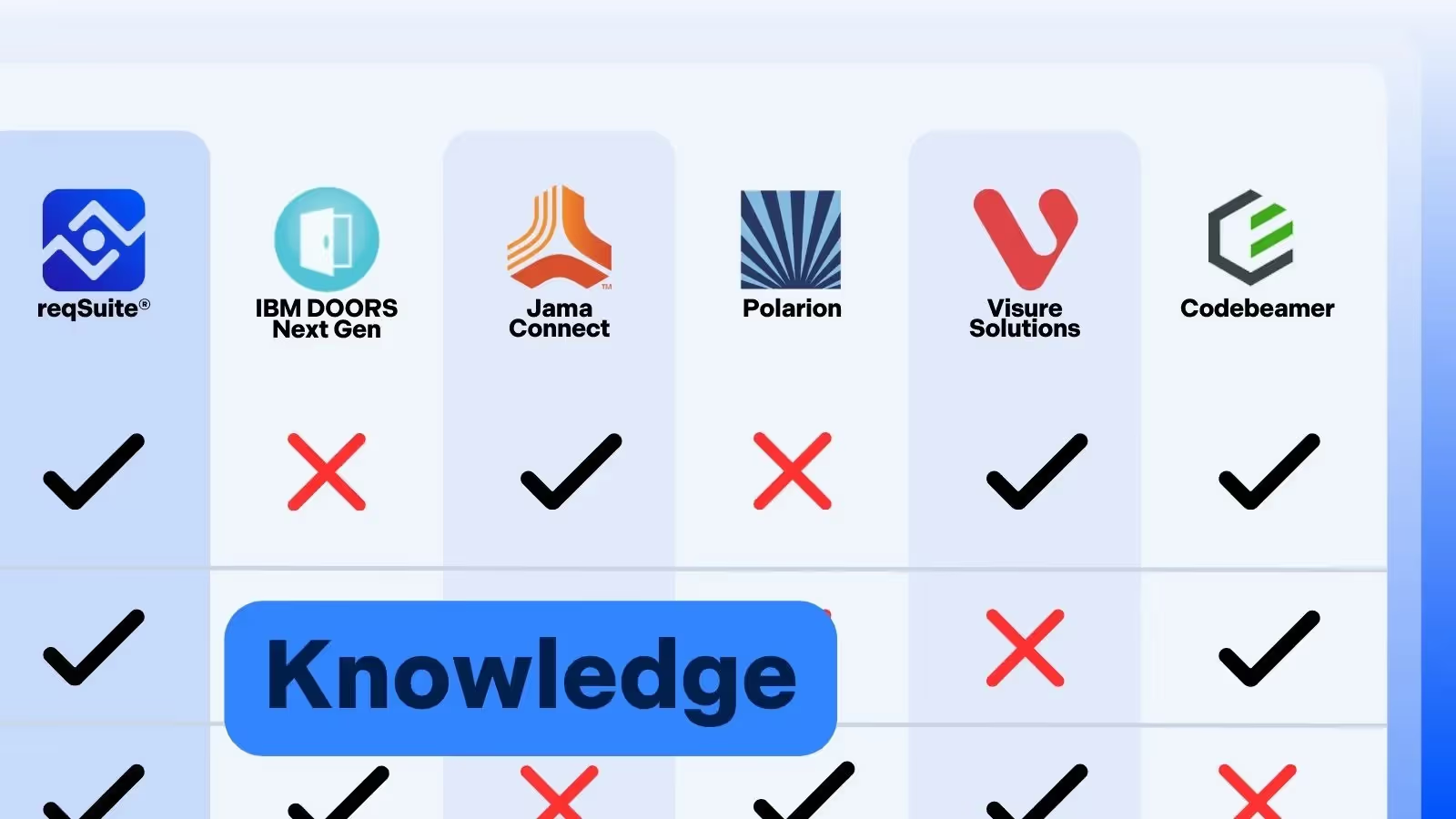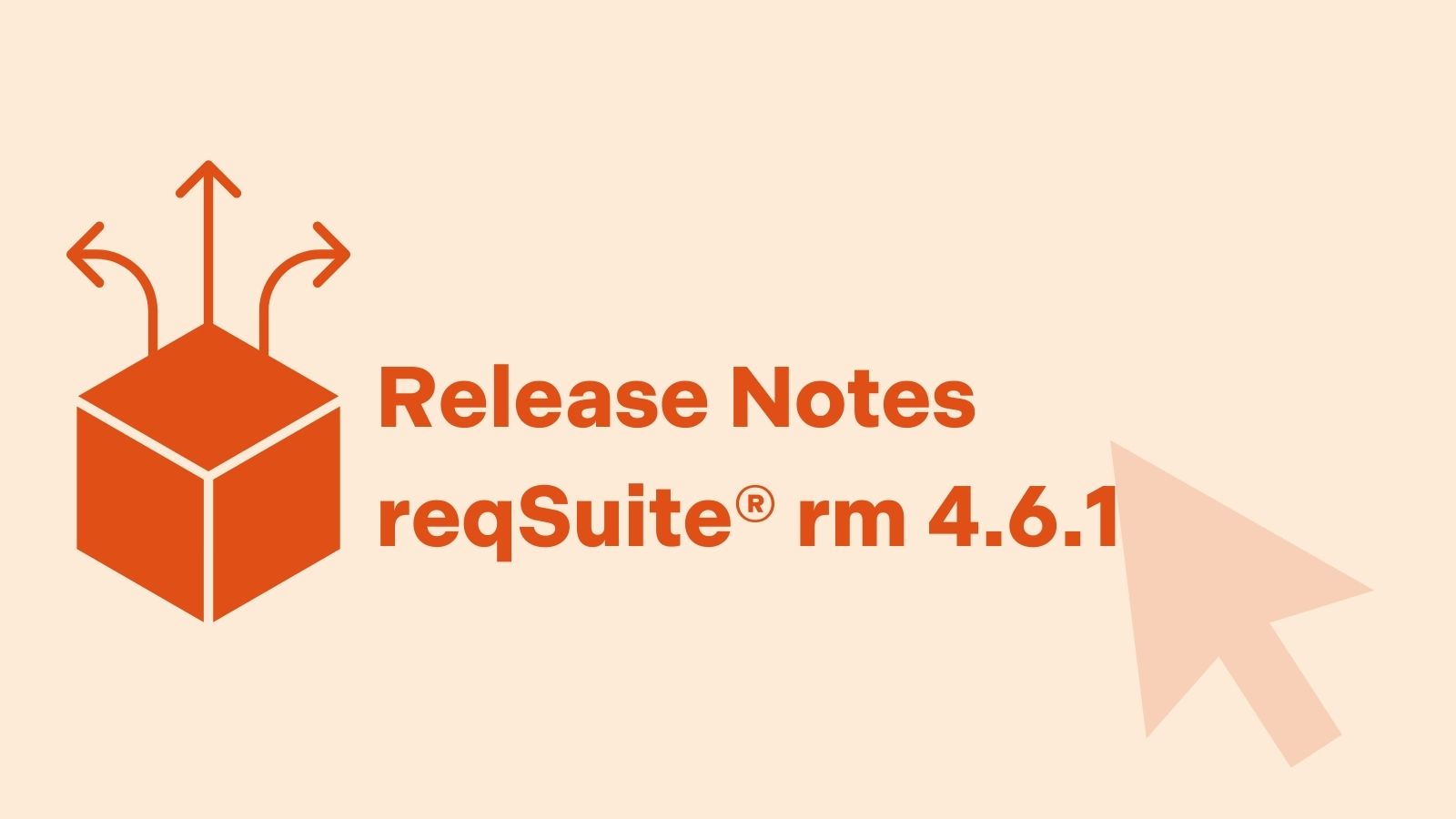
Dr. Sebastian Adam
Managing Director & Co-Founder
The best requirements management you've ever had.
Intuitive to use
Reliable in results
Efficient in processes

How to Optimize Your Requirements Management Process Effectively
2025-07-03
20
minutes reading time

Why an efficient requirements management process is the key to project success
Many companies underestimate how crucial a structured requirements management process is for the entire course of the project. Unclear requirements or inadequate documentation often lead to development projects stalling or products not meeting the desired expectations.
Benefits that make a clear difference
An efficient requirements process helps to ensure that teams have a clear idea of which requirements need to be implemented, how they are prioritized and what dependencies exist right from the start. This reduces errors, saves time and resources and achieves higher product quality.
The 5 most common stumbling blocks in requirements management - and how to avoid them
An inefficient requirements management process can have a significant negative impact on a project. The most common challenges that companies face in this area are described below:
- Unclear and frequently changing requirements
One of the most common stumbling blocks in requirements management is the lack of clarity and stability of requirements. Requirements are often formulated imprecisely or ambiguously, so that different stakeholders interpret them differently. This leads to inconsistencies in development and carries the risk that the end product does not meet the actual expectations. Another problem is the constant change of requirements over the course of the project. While it is normal for requirements to evolve, if they are not managed in a controlled and structured way, this can have significant negative consequences. Development results then have to be revised several times, which not only causes additional costs, but also means extra work for planning, documentation and testing.
Invisible risks: Lack of traceability costs time, money and trust
- Lack of traceability of requirements
Another major problem is the lack of transparency about where a requirement comes from, how it has changed and where in the system it was implemented. Without complete traceability, it is difficult to analyze requirements in a targeted manner and understand their impact on the overall project.
As a result, difficulties arise because it is not clear which original requirement may be incorrect or outdated.The consequences of a lack of traceability are particularly evident when changes need to be made. Developers often do not know which requirements have already been tested or released and have to laboriously trawl through documentation or old emails to find an answer.
Communication gaps, priority chaos & tool breaks: Why teams fail - and how to prevent it
- Poor communication between stakeholders
Requirements management is not an isolated process. It requires close collaboration between various stakeholders, including customers, developers, project managers, testers and management. If communication is not clearly regulated, misunderstandings arise that can have serious consequences as the project progresses.
A common example is that customers or technical experts formulate requirements in very general language, while developers need a technical specification. This discrepancy means that developers either have to make assumptions or constantly ask questions, which slows down the entire process.
In addition, it can happen that changes or new requirements are not passed on to everyone involved. As a result, some teams are still working with old information while others are already implementing new requirements. Such inconsistencies cause unnecessary iterations and increase the risk of undesirable developments.
- Lack of prioritization of requirements
Not all requirements are equally important. Nevertheless, many projects lack a structured prioritization process. This leads to unimportant or less critical requirements being implemented, while essential functions are considered too late or not at all.
One example is the development of a new software product, where the design and smaller features are completed early on, while fundamental core functions are developed late. This can result in the product not being marketable or not meeting key customer requirements. Unclear prioritization can also lead to inefficient use of resources. If a development team works on a feature that will later be changed or deleted anyway, valuable time is lost.
- Lack of integration with other development processes
Requirements are not isolated, but are closely linked to the development, testing and validation processes. If these processes are not seamlessly interlinked, this can lead to media discontinuities and inefficient workflows.
A classic example is the manual transfer of requirements from a document to a test system or a ticket system for developers. Such manual processes are not only prone to errors, but also cost unnecessary time.
If test cases are not automatically derived from requirements or developers first have to laboriously gather requirements, this can lead to delays and quality problems.
How companies turn challenges into competitive advantages
Companies that systematically tackle these challenges by using clear processes, modern software solutions and proven methods can make their development projects more efficient, transparent and successful.
Proven methods for optimizing your requirements management process
An efficient requirements management process contributes significantly to the success of a project. To achieve better results in the long term, companies should rely on proven methods that enable structured, transparent and comprehensible management of requirements.
What successful teams do differently: 5 methods that make the difference
The following five measures help to overcome the typical challenges and make the entire process more efficient.
Establish clear processes and standards
One of the most important foundations for successful requirements management is the establishment of clear, standardized processes. Requirements must be collected, documented and maintained uniformly in order to avoid misunderstandings and inconsistencies.
How can this be implemented, for example?
- Standardized templates: Uniform documentation templates help to record requirements in a structured and complete manner. For example, requirements can be documented in a specific format template with mandatory fields for objectives, acceptance criteria, priority and dependencies.
- Checklists for completeness: A predefined checklist can ensure that all relevant aspects of a requirement are taken into account - e.g. functional and non-functional requirements, security aspects or compliance requirements.
- Defined roles and responsibilities: It should be clearly regulated who collects, checks, approves and follows up on requirements. This ensures that everyone involved knows their tasks and that no requirements are lost.
A well-established standard process not only makes day-to-day work easier, but also helps new team members to familiarize themselves more quickly.
Systematically record and document requirements
Systematic recording, documentation and management are essential in order to make requirements clearly understandable and verifiable.
How can this be implemented, for example?
- Templates for describing requirements: A standardized structure is crucial in order to record requirements clearly, completely and comprehensibly. By using standardized templates, recurring elements such as objectives, acceptance criteria or dependencies can be systematically mapped. This ensures consistency, reduces scope for interpretation and facilitates understanding in downstream processes.
- Central platform for documentation: Requirements should not be scattered in separate documents or emails. Instead, a central platform (e.g. a requirements management tool such as reqSuite® rm) is useful for storing all requirements in a traceable, versionable and structured manner.
- Link requirements with other artifacts: Requirements should not be documented in isolation, but should be linked to relevant artifacts such as test specifications, development tasks or validation reports. This facilitates traceability and shows the entire life cycle of a requirement.
This ensures that all relevant information is available and that requirements can be understood by all parties involved.
Involve stakeholders at an early stage
Successful requirements management requires close cooperation between all parties involved. In order to avoid misunderstandings and undesirable developments, stakeholders should be involved in the requirements process at an early stage.
How can this be implemented, for example?
- Regular workshops: Workshops help to jointly develop requirements at an early stage and clarify open questions directly.
- Feedback rounds with stakeholders: Regular coordination with customers, developers and specialist departments helps to ensure that requirements are understandable and can be implemented realistically.
- Review processes: Requirements should be reviewed and released at defined intervals in order to minimize subsequent changes.
Involving stakeholders at an early stage provides more clarity, reduces rework and ensures that the developed product meets the actual needs.
Define clear prioritization mechanisms
Not all requirements are equally important - objective criteria are therefore needed to decide which requirements should be implemented first.
How can this be implemented, for example?
- MoSCoW method: Requirements are divided into four categories:
- Must-have (essential requirements)
- Should-have (important but not critical requirements)
- Could-have (useful but optional requirements)
- Won't-have (requirements that are not implemented in this version)
- Cost-benefit analysis: Requirements are evaluated according to how much effort is required to implement them and what benefits they bring to the company or the customer.
- Business value analysis: Requirements with high strategic importance or direct business benefits should be prioritized.
A clearly defined prioritization mechanism ensures that the right requirements are implemented at the right time.
Optimize version control and change management
Requirements are rarely set in stone and evolve over the course of a project. Efficient change management is crucial in order to document changes in a controlled and traceable manner.
How can this be implemented, for example?
- Version control for requirements: Every time a requirement is changed, a new version should be created so that it remains traceable which changes were made and when.
- Approval process for changes: Changes should not be made spontaneously, but should go through a defined process where they are reviewed and approved.
- Document change history: Every requirement change should be documented with a justification to avoid subsequent queries.
Well-organized change management ensures greater transparency and reduces the risk of incorrect or outdated requirements being implemented.
These principles guarantee the success of your requirements management
Sustainable and efficient requirements management is based on clear processes, systematic documentation, early involvement of stakeholders, well thought-out prioritization mechanisms and structured change management. Companies that implement these principles can significantly improve the quality of their requirements, minimize risks and make their development processes more efficient.
How modern requirements management tools support your daily work
A professional requirements management tool is a central component for the efficient management of requirements and makes a significant contribution to quality assurance and process optimization in development projects. While many companies still manage requirements in unstructured documents or Excel spreadsheets, specialized tools offer decisive advantages: they enable systematic recording, structured management, better collaboration and seamless integration with other development processes.
The most important advantages and functions are described in more detail below:
Automated traceability for more transparency
A decisive advantage of modern requirements management tools is the seamless traceability of all requirements.
How does this work in modern tools?
- Versioning: Each requirement is provided with a unique version history. Changes can be traced at any time so that teams can restore older versions.
- Dependency management: Requirements are often interlinked - a change can have an impact on other requirements or system components. A professional tool visualizes such dependencies and warns if a change could have a critical impact.
- Audit trail: A complete change log shows who made which adjustment and when. This facilitates both quality assurance and compliance with regulatory requirements.
Practical example:
In regulated industries such as medical technology or aerospace, complete traceability is required by law. A company that develops a medical device must be able to prove which requirements were changed and when, and how this affects tests and approvals. This would hardly be possible without an RM tool.
Better collaboration through centralized management
A modern requirements management tool provides a central, standardized platform that enables all stakeholders to access the latest information in real time.
How does this work in modern tools?
- Real-time synchronization: Changes to requirements are immediately visible to all team members, regardless of whether they are working remotely or in the office.
- Comment functions & approval processes: Stakeholders can provide feedback or approvals directly on requirements without having to rely on lengthy email communication.
- Role and rights management: Teams can be given targeted access to specific requirements so that everyone only sees the information relevant to them.
Practical example:
A software development company uses an RM tool to centrally manage all requirements for a new application. Product managers can specify new features, while developers leave feedback directly and testers use the test cases derived from the requirements. This ensures that all teams are on the same page and that there is no contradictory information.
Integration with development and test tools
A professional requirements management tool does not work in isolation, but integrates seamlessly into existing development and testing processes.
How does this work in modern tools?
- Interfaces to development tools: Many tools can be connected to common development platforms such as Jira or Azure DevOps so that requirements can be transferred directly into tickets or work packages.
- Automatic test case derivation: Requirements can be linked directly to test cases. Changes to requirements automatically trigger updates in the associated test cases.
- Link to change management systems: Changes to requirements can be taken into account in existing change processes so that all teams remain up to date.
Practical example:
A software development company uses an RM tool to centrally manage all requirements for a new application. Product managers can specify new features, while developers leave feedback directly and testers use the test cases derived from the requirements. This ensures that all teams are on the same page and that there is no contradictory information.
Fewer errors, more clarity: Why standards and consistency are crucial
Quality assurance through validation tools
Modern requirements management tools offer the option of automatically checking requirements for consistency, clarity and completeness.
How does this work in modern tools?
- Automatic consistency check: The system recognizes contradictory requirements and draws attention to them.
- Linguistic quality control: Some tools use AI-supported algorithms to identify vague or ambiguous formulations.
- Completeness check: The system ensures that all the necessary information on a requirement is available before it is processed further.
Practical example:
A medical technology company is developing a new device for patient monitoring. The requirements for the system must be clear, unambiguous and testable. An RM tool automatically checks whether requirements are clearly formulated and whether all relevant test criteria are included.
Why investing in an RM tool pays off quickly
Modern requirements management tools are indispensable for efficient, transparent and high-quality requirements management. They ensure complete traceability, improve collaboration, enable seamless integration with development and test systems and help with quality assurance through automated validation.
Would you like to experience the benefits of modern requirements management tools for yourself?
Request a free demo now and discover how you can make your development processes more efficient, transparent and future-proof.
{{inline-cta}}
Step by step to a successful requirements management strategy
Efficient requirements management requires a structured and well thought-out approach. Improvements cannot be achieved through individual measures, but must be implemented systematically - ideally with a strong partner at your side.
In 6 steps, we make your requirements management process future-proof and efficient
- Step 1: Analyze existing processes
The first step is to take a critical look at the current situation: Where are the current requirements management processes lacking? Common weaknesses are unclear requirements, a lack of traceability or inefficient team communication. Workshops, interviews and process visualizations help to make specific bottlenecks visible. - Step 2: Define clear processes
Based on the analysis, transparent, standardized processes are created - from requirements elicitation to release. Clear responsibilities, understandable documentation standards and comprehensible prioritization criteria are important. - Step 3: Use the right tool
A professional requirements tool is the key to efficiency. It should manage requirements centrally, document changes seamlessly and be able to be integrated into existing systems such as Jira or Azure DevOps. Collaboration and review mechanisms ensure quality and transparency. - Step 4: Train the team in a targeted manner
New processes only work if everyone involved knows how to use them.Training courses teach the basics, best practices and how to use the tool safely - in a practical way, across teams and with a view to everyday life. - Step 5: Test in a pilot project
A pilot project shows how the new processes work in practice, provides valuable feedback and enables targeted adjustments to be made - before the rollout goes live. - Step 6: Continuous improvement
Requirements management is not a one-off project. Regular reviews, targeted KPI analyses and an open feedback culture help to continuously optimize processes and adapt them flexibly to new requirements.
By consistently developing requirements management, the company remains competitive and can manage development projects efficiently and in a targeted manner.
Conclusion
An optimized requirements management process helps you to carry out development projects in a more efficient, structured and error-free manner. Clear processes, early involvement of stakeholders and the use of a powerful tool are key success factors.
Why it is particularly worth taking the first step now
Optimize your requirements management process and benefit from the advantages of modern technologies.
Get in touch with us now. We will support you in finding the right strategy and the best tools for your requirements!
About the author

Dr. Sebastian Adam
Managing Director & Co-Founder
Dr. Sebastian Adam has been intensively involved in requirements management for over 20 years. His expertise and experience make him a recognized expert on the challenges and best practices in this area. In 2015, he founded OSSENO Software GmbH to help companies simplify, streamline and future-proof their requirements management processes. With the reqSuite® rm software developed by his company, he has created a solution that enables organizations to capture, manage and continuously improve their requirements in a structured way. His mission: to combine practical methods with modern technologies in order to offer companies real added value.
Other interesting articles

Knowledge
12
minutes reading time
Interfaces in Requirements Management Tools: How to Create Real Integration Instead of Data Silos

Johanna Lotter
2025-06-02

Tips
3
minutes reading time
“It's like using a sledgehammer to crack a nut!" - Fatal shortsightedness in the introduction of an RM tool

Dr. Sebastian Adam
2025-05-13

Tech
8
minutes reading time
AI-Supported Assistance Functions in reqSuite® rm

Dr. Sebastian Adam
2025-01-06

Knowledge
10
min. reading time
Requirements Management Tools 2026: A Comparison for Medium Sized Product Developers

Neele Borkowsky
2025-12-08

Tech
5
min. reading time
Release Notes reqSuite® rm 4.6.1

Phil Stüpfert
2025-12-07

Knowledge
18
min. reading time
Improving Processes in Product Development: 5 Proven Best Practices

Neele Borkowsky
2025-11-07











